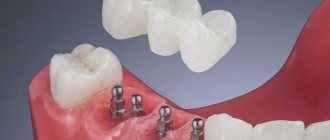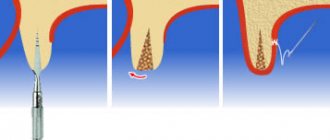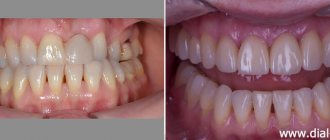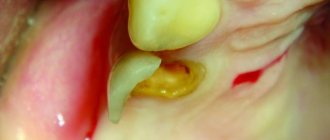- What is atrophy
- Types of atrophy
- Osteoplasty
- Implantation methods
- Alternative Methods
- Prices
- Work examples
- Doctors
- Reviews
Bone atrophy is the process of cell destruction due to disruption of tissue nutrition. The process can be stimulated by tooth loss, gum disease, endocrine diseases, infections, and the age factor. Implantation with a lack of tissue is difficult: there is no way to correctly position and fix the implant. Implantation is carried out using the classical method (with mandatory preliminary osteoplasty) or according to the protocol with immediate loading (bone grafting is indicated only in conditions of severe atrophy).
- When used:
missing 1 or more teeth due to bone deficiency - Type of anesthesia:
local anesthesia - Procedure time:
from 15 minutes - Treatment period:
up to 4 months - Healing period:
up to 7 days - Age restrictions:
from 18 years old
What is bone atrophy
Bone atrophy, or loss, is a result of tooth loss. Due to uneven load, the jaw loses volume - in the first year, tissue loss is 25%.
Atrophy can be stimulated by gum disease, endocrine, infectious diseases and the age factor. In patients, the blood supply to the jaw deteriorates, there is a lack of oxygen - the pressure on the tissue changes. The central or spongy layer, which has a porous structure, is subject to the process.
Jaw deformation has different intensity:
- I degree.
The blood supply is not impaired. It is possible to install a classic implant. - II degree.
The mucous membrane contracts. The operation is performed after plastic surgery. - III degree.
The contour is smoothed from the chin and in the oral cavity. Bone augmentation is a must.
The results of the deficiency are expressed in deterioration of speech, changes in facial proportions, and the appearance of wrinkles in the oral area. An advanced degree of atrophy causes displacement of the dentition, loss of adjacent or opposite units. Classical implantation is not possible with bone atrophy.
Balloon sinus lift
Balloon sinus lift is used for those patients whose bone height is 3-4 mm. The advantage of this method is that the implant is installed immediately after the sinus lift is completed.
The essence of this method is very similar to the technology of closed sinus lift. Raising the floor of the maxillary sinus and filling the space with synthetic dental tissue is done in the same way as with a closed sinus lift. The same surgical instruments are used.
The difference is that a thin catheter with a balloon is inserted under the mucous membrane, into which a special radiopaque liquid is then injected. The balloon begins to expand and thereby delicately peel off the mucous membrane. This method allows the implant to be implanted immediately after the sinus lift is completed.
Types of bone atrophy in the upper and lower jaw
Destruction of the bone structure of the upper jaw is fraught with injury to the closely localized maxillary sinus. The cells in this area have a loose structure, the bone is thinner, and is actively resorbed in the area of the masticatory elements. When fixing long implants, there is a risk of injury to the sinus membrane, which can stimulate its rupture and the development of sinusitis or chronic runny nose.
The Schroeder classification identifies three types of atrophy of the upper jaws
:
- The jaw tubercles are pronounced, physical abnormalities are not visible, the mucosa is noticeably curved, the palate is deep. Implantation is possible without complications.
- The alveolar processes are not clearly expressed, the palate is of medium depth. Installing implants using the classical method is doubtful, but using a one-stage method is possible.
- The cells are seriously atrophied, the alveolar processes are smooth, the palate is flat, the fold at the level of the palate does not hold its shape. Fixation of classical implants is not possible; it can be done in one stage, depending on the location of the defect.
The tissue of the lower jaw is dense from below and does not decrease so rapidly, but as atrophy progresses, the dentist is faced with the problem of the nearby localized mandibular nerve (it is located under the roots of natural elements). Nerve injury can cause complete or partial loss of sensation in the lower facial part.
According to Keller, there are four types of mandibular atrophy
:
- The tubercles of the alveoli are visible on the jaw, a fold of the mucous membrane is noticeable. You can install classic or one-stage implants.
- The ridge becomes sharper, and muscles are attached at its base. Installation of a classic implant may cause discomfort, but a one-stage implant does not cause complications.
- The jaw of patients with early removed lateral teeth - the alveoli are thinned, the volume in the center does not decrease. It is not possible to implant classical artificial roots; one-stage ones are possible, but there is a fear of the implant shifting when chewing food in case of a single defect.
- In the area of the frontal incisors, the bone is clearly atrophied; the lateral row is not affected. Implantation for such bone tissue atrophy is possible using a combined method.
Possible postoperative complications
After a sinus lift, the following problems may arise:
- acute chronic sinusitis;
- swelling of the palate;
- sinusitis;
- increased body temperature;
- rupture of the mucous membrane inside the maxillary sinus or its perforation;
- chronic runny nose;
- bleeding from the nose and at the operation site.
All these troubles can occur due to insufficient qualifications of the doctor and the use of low-quality materials and instruments.
Osteoplasty
Classic dental implantation for bone tissue atrophy (height less than 10 mm) is preceded by bone augmentation surgery - osteoplasty. The procedure is carried out to ensure stable fixation of the implant and to avoid aesthetic complications during subsequent restoration of the element with prosthetics. For this purpose, the implantologist acts using one of the methods:
- Sinus lift.
The operation is performed on the upper jaw - the doctor lifts and displaces the maxillary sinus, making room for new bone. - Guided bone regeneration.
Bone material is added, covered with a membrane and sutured until it fuses with the jaw. - Replanting bone blocks.
The person's own bone material is used. It is removed from the lower jaw in the area of the wisdom teeth. The bone block is fixed with screws, bone granules are placed around it, and a membrane is attached. - Splitting of the alveolar ridge.
The dentist cuts the appendage and increases its thickness using a graft or artificial material.
It takes 3-6 months for the new bone to heal. It is possible to combine osteoplasty and implantation operations. The decision-making algorithm for performing osteoplasty simultaneously with implant fixation is as follows:
- Studying the possibility of positioning the artificial root in the correct position (using wax-up and surgical templates).
- Choice of osteoplasty technique. Depends on the degree of bone atrophy and its spread in height or width.
- If it is impossible to achieve stability of the artificial root with the existing bone volume, the extension is carried out in a separate stage.
What complications occur during bone grafting surgery?
Bone grafting in dental implantology varies greatly in complexity. This could be a major transplantation of bone blocks or some minor manipulation using osteoplastic material. But any operation requires the skill of a professional and his close attention to each patient individually. Any mistake in the bone tissue augmentation procedure is fraught with complications in the form of wound inflammation, suppuration or rejection of the bone block.
Many consider soft tissue swelling to be a complication after bone grafting. However, this is rather a natural reaction of the body to the surgical intervention. Swelling, as a rule, occurs and increases during the first two to three days, and then gradually subsides. Local hematomas may also appear.
Regardless of the volume of operations, all manipulations must be planned in such a way that the patient can endure them comfortably.
How to install implants in conditions of bone deficiency
Classic dental implantation in case of insufficient bone tissue is preceded by bone augmentation surgery or sinus lift. Before implantation, a period of engraftment of the grafting material (4-6 months) is waited. During this period, the patient is fixed with a removable prosthesis.
If I and II degrees of loss are diagnosed, implantation and replanting of cells can be organized simultaneously. It is possible to exclude bone grafting if all or almost all teeth in a row are missing - artificial roots are implanted using a one-stage protocol at an angle (into the deep bone layers).
Nesterenko Alexey Pavlovich Implant surgeon, doctor of the highest category
Can implantation stop cell loss?
In addition to solving the problem of aesthetics and restoring the functionality of the dentition, installing implants helps prevent resorption. Due to the implants, the load on the jaw is distributed evenly, internal metabolic processes in the cells are activated, cellular nutrition is established - the atrophy process stops.
Contraindications
A patient may be denied a sinus lift if he or she has the following problems:
- sinusitis;
- polyps;
- chronic runny nose:
- excessive number of septa in the maxillary sinuses:
- poor bone condition.
In addition, if surgery was performed in the area of the maxillary sinuses, then sinus lifting is also contraindicated. You should also know that if you are a heavy smoker and are unable to abstain from this addiction until postoperative injuries are completely healed, then this procedure is contraindicated for you.
Classic delayed load protocol
Classic surgery is performed when there is sufficient bone tissue (at least 10 mm) in two stages. The protocol involves delayed loading on the implants: they need time to fuse with the jaw.
An implant with dismountable elements (an abutment and an intraosseous part) is fixed using the method of detaching a gum flap - the gum is cut and sutured.
2-6 months after the operation, the implant is opened, a gum former is placed on it, and two weeks later - an abutment and an individual permanent prosthesis.
1
Implantation
Implantation
2
Prosthetics
Installation of a butterfly prosthesis or temporary crown (if it is possible to remove the bite)
4-6 months
Installation of abutment and permanent crown
Osteoplasty in case of a lack of tissue is organized before the implantation of titanium roots or simultaneously. The operation is justified for single defects. If the patient has multiple defects or complete edentia, classical surgery is difficult due to acute bone loss and the need to build up a large volume of bone.
If there is not enough bone tissue for implantation, classical implants in some clinics are implanted without tissue augmentation. The doctor suggests:
- install titanium roots only in the frontal zone (signs of atrophy rarely appear here);
- fix the implant in the area of the posterior wall of the maxillary sinus at the end of the dentition, behind the maxillary sinus (the height of the bone here reaches 20 mm);
- implant short and thin implants - implantation is possible in case of atrophy of the bone tissue of the lower jaw, without touching the jaw nerve.
But the described methods are unreliable: the risk of weak primary stability of the implant and its loosening cannot be excluded. The most reliable method in case of severe atrophy of bone tissue in the upper jaw can be pterygoid implants
ROOTT. These implants are longer than classic ones and are implanted into the zygomatic bone, bypassing the maxillary sinuses. Pterygoid implantation differs from zygomatic zygomatic implantation in its safety and low trauma.
When performing an operation, it is important to use implants from the same manufacturer (with the same impurities - metals in a titanium alloy). When fixing implants, impurity metals of different brands in the acidic environment of the oral cavity may not combine and cause allergies, galvanic syndrome, and rejection of titanium roots. The ROOTT implant system is unique: a range of implants from one manufacturer is used in all clinical cases.
Open sinus lift
An open sinus lift is done in four stages and is a very complex operation.
First, the surgeon makes a thin hole in the gum and the bone under it, while he achieves a slight separation of the upper jaw bone from the gum.
At the second stage, using special surgical instruments, the doctor slightly lifts the bottom of the nasal (maxillary) sinus.
The essence of the third stage of the operation is to fill the vacated space with artificial bone material. This is done through the hole that the surgeon originally made.
During the final fourth stage, the surgeon returns the detached part of the bone tissue to its place and sutures the wound.
This type of operation is recommended for significant lack of bone tissue in the lateral parts of the upper jaw.
One-stage protocol with immediate loading
A one-stage operation is performed if 3 or more teeth are missing. The protocol helps avoid tissue buildup. Single-component (not divided into an abutment and an intraosseous part) implants are installed in the deep layers of bone, which are not subject to resorption. For a larger area of contact between the bone and the titanium root, the product is fixed at an angle, identifying areas of bone tissue that are less susceptible to atrophy.
The implant is implanted using a minimally invasive method: it is screwed through a puncture in the gum. The top of the artificial root (abutment) rises above the gum - the dentures are installed immediately after implantation (on 2-3 days). After a year, the lightweight adaptive prosthesis is replaced with a permanent one.
1
Implantation
Implantation of 8-12 implants into deep bone layers (without bone grafting)
2 - 3 days
2
Prosthetics
Fixation of an adaptive prosthesis with a titanium arch and metal-plastic crowns
in a year
Permanent prosthetics
One-stage dental implantation for abnormal bone deficiency (less than 2.5 mm) is impossible without tissue augmentation. The operation is not performed for large maxillary sinuses, which cannot be avoided when installing implants at an angle.
Among the complexes of the one-step protocol:
- All-on-4.
The technique is used if the patient is missing all the teeth on the jaw. The dentition is restored using 4 implants (2 in the smile area and 2 on the sides). To avoid complications, “all-on-4” implantation for atrophy of the bone tissue of the upper jaw is carried out with caution, taking into account the close location of the maxillary sinuses. - All-on-6.
A modernized version of the All-on-4 method (implantation for severe bone deficiency). The increased number of supports (6 instead of 4) expands the scope of application of the method and allows for more stable fixation of the structure. - Basal implantation.
The method is used for acute bone loss. Suitable for missing three or more teeth in a row. For complete edentia, 8-12 implants are used on one row of teeth. They are fixed into the deep layers of the jaw bone.
All-on-4 and all-on-6 protocols involve the use of surgical templates to determine the location of the implant, without taking into account the condition of the bone. With basal implantation, templates can be dispensed with; this expands the scope of application of the technique. Implantologists at the ROOTT Clinic, using computed tomography, select suitable jaw sites for fixation with sufficient bone volume. If circumstances require it, a couple of additional implants are installed free of charge - if one of the titanium roots does not take root, there are enough implants left for prosthetics.
Donor materials
The following can be used as donor materials:
- Protein molecules that are similar in structure to the original bone. They are responsible for starting the process of cell regeneration.
- Membranes made of collagen and impregnated with a regenerating composition.
- Hydroxyapatite compounds, membrane barriers and bone granules.
- Biologically active compounds together with a variety of distracting drugs.
The best solution seems to be the combination of several materials when performing guided bone regeneration. Not only bone tissue is suitable for this, but also blood cells, synthetic fibers, and so on. If you add the patient's blood to crushed bone granules, regeneration will be more active and survival rate will improve.
Stages of guided bone regeneration surgery
Guided regeneration around implants is performed in several stages:
- Using a scalpel, the doctor removes the periosteal flap. During tissue incision, the point is taken into account that in the future the membrane installed in the sinus should not touch the root system. The distance should be about 4 mm, otherwise the proliferation of bacteria and the development of an inflammatory process in the oral cavity cannot be avoided.
- The optimal size of the implanted plate for a particular case is selected, with an emphasis on the specifics of soft tissues and parameters of bone restoration.
- Decortication of the surface of the hole is carried out. For this purpose, spherical burs and fissures of compact sizes are used. In some cases, the doctor uses thin drills. Provides access to the drugs necessary for the rapid restoration of the affected area and to activate blood circulation in the jaw.
- The membrane is installed. Titanium feints are used, the attachment location is chosen in an inconspicuous area. After installing the first side, regenerating drugs are administered, only after that the doctor begins to fix the second side. It is important to achieve maximum fit, otherwise soft tissue will grow into the formed folds, which will negatively affect the result of the dental operation.
- The flaps are sutured over the membrane. It is important that the surgeon uses the thinnest threads. It is also necessary to match the boundaries of the incisions as accurately as possible - in this case, healing is accelerated and the risk of inflammation is eliminated when food debris enters the sinuses.
- At the final stage, the doctor disinfects the suture. The implant is installed after final bone regeneration.
If you are interested in restoring your teeth using soft tissue grafting, start with a consultation. Visit the official website of the medical center - make an appointment with a doctor online. During the initial examination, the doctor will diagnose existing diseases, if any, and prescribe treatment.
Alternative Methods
Removable dentures Recommended if there are absolute contraindications to implantation or if there is a limited budget
ReSmile Modern technology for rapid restoration of teeth with complete edentia with the installation of a permanent prosthesis
Mini-implants Removable prosthetics with mini-implants MDI
Article Expert
Nesterenko Alexey Pavlovich Surgeon-implantologist, doctor of the highest category
Work experience: more than 11 years
Indications
The operation allows you to increase the “necessary” volume for high-quality classical implantation, helps restore the functions of the jaw, and returns the gums to an attractive appearance.
The bone is built up “with reserve”, since after the operation the surface layers will be supplied with a small amount of oxygen due to their lower blood circulation. Therefore, the volume of inevitable tissue resorption is calculated.
In addition to implantation, indications for NRC are:
- rapid restoration of physiological parameters after tooth extraction;
- congenital or acquired defects of the bone around the teeth;
- prevention of tooth displacement, loosening, and loss due to periodontal tissue diseases.
Why does atrophy occur?
Prices
The cost of the operation depends on the chosen technique. The most expensive will be implantation with preliminary osteoplasty: the process is labor-intensive and expensive artificial material is used.
A classic operation and a protocol with an immediate load will cost approximately the same if several elements need to be restored. When a complete or almost entire row of teeth is missing, one-stage implantation is cheaper due to fewer implants and a reduction in the number of operations.
Free online consultation with a dentist
| Service | Price |
| Directed regeneration in the area of 1 tooth (excluding material cost) | from 10,000 rub. |
| Sinus lifting in the area of one tooth (excluding the cost of material) | from 10,000 rub. |
| Installation of a classic implant ROOTT FORM (Switzerland, Trate AG) | from 27,000 rub. from 32,000 rub. promotion |
| Guided bone tissue regeneration (for 1 zone excluding material cost) | from 35,000 rub. |
| Open sinus lift, bone grafting (for 1 zone, excluding material cost) | from 35,000 rub. |
| Osteoplasty with splitting of the alveolar ridge (for 1 zone excluding the cost of material) | from 35,000 rub. |
| Installation of a one-stage implant (Switzerland, Trate AG) with an adaptation crown | from 44,000 rub. |
| Installation of a classic ROOTT implant with an adaptation crown (Switzerland, Trate AG) | from 44,000 rub. |
| Installation of a one-stage multi-unit implant with screw fixation (Switzerland, Trate AG) with an adaptation crown | from 50,000 rub. |
| Installation of a classic Nobel implant (Sweden, Nobel Biocare) | from 60,000 rub. |
| Installation of a classic Nobel implant (Sweden, Nobel Biocare) with an adaptation crown | from 85,000 rub. |
| One-stage complex implantation for completely edentulous one jaw, including an adaptive prosthesis (combination of 6-12 COMPRESSIVE, BASAL implants of the ROOTT system (Switzerland, Trate AG) on a metal frame with cement fixation. | from 265,000 rub. |
| One-stage complex implantation for completely edentulous one jaw, including an adaptive prosthesis (combination of 6-12 COMPRESSIVE, BASAL implants of the ROOTT system (Switzerland, Trate AG) on a titanium frame with cement fixation | from 230,000 rub. from 295,000 rub. promotion |
| One-stage complex implantation for completely edentulous one jaw, including an adaptive prosthesis on a titanium frame supported by 6-12 implants of the ROOTT system (Switzerland, Trate AG) multi-unit with screw fixation | from 295,000 rub. from 325,000 rub. promotion |
| One-stage complex implantation with complete edentia of both jaws, including an adaptive prosthesis (combination of 12-24 COMPRESSIVE, BASAL implants of the ROOTT system (Switzerland, Trate AG) on a metal frame with cement fixation | from 480,000 rub. |
| One-stage complex implantation with complete edentia of both jaws, including an adaptive prosthesis (combination of 12-24 COMPRESSIVE, BASAL implants of the ROOTT system (Switzerland, Trate AG) on a titanium frame with cement fixation | from 495,000 rub. |
| One-stage complex implantation for completely edentulous 1 jaw, including a ceramic-composite prosthesis, put on on days 3-4, a combination of 6-12 screw-fixed implants, ROOTT system (Switzerland, Trate AG). No re-prosthetics required | from 580,000 rub. |
| One-stage complex implantation with complete edentia of both jaws, including an adaptive prosthesis on a titanium frame supported by 12-24 implants of the ROOTT system (Switzerland, Trate AG) multi-unit with screw fixation | from 590,000 rub. |
Consultation and diagnostics are free!
All prices Promotions
Preparing for surgery
Like any other operation, sinus lift requires patient preparation. The surgeon will never decide to operate until he is sure that the patient’s maxillary sinuses are normal. To do this, a detailed examination is carried out with mandatory x-rays. If there is the slightest deviation from the norm, surgery cannot be performed.
Also, in preparation for a sinus lift, a complete examination of the patient’s body condition is carried out.
Perhaps it wouldn’t hurt to give some good advice here. If the clinic where you are planning to go for a sinus lift does not have a 3D computed tomograph, then it is better to look for a more reputable clinic that has this expensive medical device. The fact is that only it allows you to get a complete picture of the state of a person’s internal organs.
Studio Dent purchased a computer tomograph for 6 million rubles, and this was done not for the sake of advertising or profit, but for the sake of obtaining impeccably accurate examination results.
Also, in preparation for surgery, the patient may be prescribed a course of medication. Most often this is taking antibiotics to prevent bacterial infections. Steroids may also be prescribed to promote rapid wound healing and reduce the likelihood of inflammation.
Work examples
All works
Implantation for 2 jaws with artificial gum
Complete restoration of the upper jaw on implants
Complete restoration of the upper jaw using a zygomatic implant
Stage III periodontal disease: complex dental implantation Restoration of both jaws in 4 days
Sinus lifting with simultaneous implantation
Implantation of both jaws with ROOTT implants for stage II periodontal disease
Restoration of two jaws with one-stage implantation using sinus lift
Sinus lift with simultaneous implantation
All works
Sign up for a consultation
three ROOTT specialists + diagnostics as a gift











